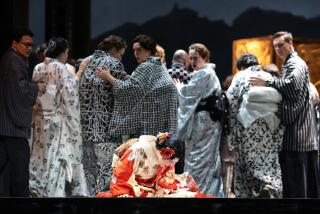The art of talking in movie theaters
- Share via
Long before the tiny, talking heads of “Mystery Science Theater 3000” yammered their brainy commentary over well-worn sci-fi films, there was the benshi.
During the heyday of silent films, Japanese audiences flocked to see the latest imports from the West, but it was the translators, or benshi, who stole the show.
The benshi were beloved cultural conduits. They were narrators that carried on a continuous monologue through the film, competing against the swells of a backing orchestra and outbursts from the audience.
Neelanjana Banerjee curates tonight’s “neo-benshi” performance at Echo Park art gallery Machine Project, featuring six other writers, artists and filmmakers from Los Angeles and the Bay Area. “It can be as much about wordplay as it is about telling a story,” she says.
The postmodern twist applied to performances like those at Machine Project takes its cue from the Japanese originators, who were doing their best to explain the baffling customs of the West.
The benshi voiced every character on the screen, recited impromptu bits of poetry, discussed the significance of background settings and occasionally cracked wise about a silly plot or a heroine’s large hands.
By the early 1930s, before the dominance of “talkies” in Japan, the predominantly male benshi were so popular that their names appeared on the marquee, next to stars like Douglas Fairbanks and Raymond Griffith.
Though their storytelling art -- called katsuben -- declined with the eventual introduction of sound, benshi like Midori Sawato still tour, performing in movie houses worldwide.
Sawato is perhaps the best-known modern practitioner of katsuben, or setsumei, which dates back to the late 1890s, when the first film canisters from Thomas Edison and the Lumieres made their way across the Pacific Ocean.
Bay Area filmmaker Konrad Steiner saw Sawato perform in the fall of 2002. “You got the real sense that she was an actress, not simply reading from a script.”
Steiner began proposing “neo-benshi” projects among the San Francisco community of poets. Writers could explore personal themes, using the muted film as a moving canvas.
Working with poet and translator Jen Hofer, Steiner produced a series of neo-benshi nights. Writers created their own 10-15 minute neo-benshi projects using popular films such as the noir “Kiss Me Deadly” and “Indiana Jones and the Temple of Doom” as a backdrop to explore themes as varied as nuclear testing and race relations.
“Writing ‘to’ a film is incredibly challenging, in the sense that film is a durational art,” says Hofer. “The process of literary translation doesn’t let you stray from the original. The benshi can create any number of [alternative] iterations.”
Tonight’s performance includes musical versions from percussionist Corey Fogel and violist Cat Lamb’s interpretation of Robert Bresson’s 1983 film “L’argent.”
Steiner, who performs a re-imagination of the opening scene of “Minority Report,” thinks that the most successful neo-benshi meld the film into the performer’s text, rather than having the film act as a two-dimensional illustration.
“It’s like an invasion of the film. Or, rather,” Steiner pauses, “an occupation.”
--
--
Neo-benshi night
Where: Machine Project, 1200 N. Alvarado, L.A.
When: 8 tonight
Price: Free
Contact: (213) 483-8761
More to Read
Only good movies
Get the Indie Focus newsletter, Mark Olsen's weekly guide to the world of cinema.
You may occasionally receive promotional content from the Los Angeles Times.










